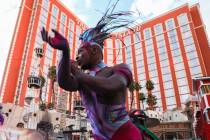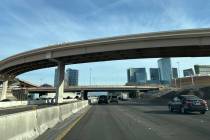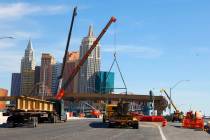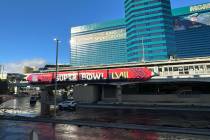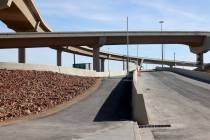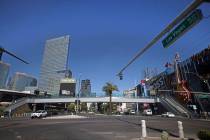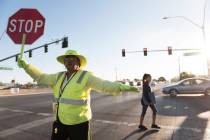Buses and barriers, bicycle and HOV lanes
This week the Road Warrior dons his law school cap and tries to clarify a couple of road laws that are baffling readers, and we learn more about our new high-occupancy vehicle lanes. Also, we learn where you can catch up on the news from July just by stopping by the Nevada Department of Motor Vehicles office on Sahara Avenue.
Artie asks whether motorists headed in both directions must stop for school buses that are stopped to let off children, if the road has a barrier of some sort.
As long as there is a barrier presenting a physical impediment to vehicles from entering the other side of the road, traffic headed in the opposite direction of a stopped school bus need not stop, said Capt. Tom Conlin, head of the Metropolitan Police Department’s traffic section.
Nevada Revised Statute section 484.357 states that every vehicle traveling in either direction must stop for a school bus stopped to pick up or drop off a student, unless (and this is in section 2) the school bus is on the other side of a divided highway.
So what is a divided highway? According to NRS 484.048, it is one divided by a physical barrier of some sort that impedes vehicles.
Conlin said law enforcement in Clark County takes that to be a concrete curb seen in the middle of most major roads, or a lengthy dividing dirt area often seen on highways.
Ron Roth wants to be absolutely sure it is legal for a motorist to make a right turn from a bicycle lane.
Apparently, Ron feels there was conflicting information about this issue given out by my preceding road warmongering colleagues: Michael Squires, a graduate of an Ivy League university, and Omar Sofradzija, who now works at a prestigious university in Michigan.
I may be neither made of Ivy nor prestigious, but I know the answer.
Back to the old NRS — it’s a good thing I’ve taken some paralegal courses in my time.
Section 484.324, subsection 2, states: “The driver of a motor vehicle shall not enter, stop, stand, park or drive within a pathway or lane provided for bicycles except when entering or exiting an alleyway or driveway; when operating or parking a disabled vehicle; to avoid conflict with other traffic; in the performance of official duties; in compliance with the directions of a police officer; or in an emergency.”
Taken on face value, that would make the answer to Ron’s question no.
But there is more to it than that. State statute also says vehicles must be in the farthest right-hand lane when making a right turn.
Conlin explained that drivers, when making a right turn at a corner or a driveway or into an alleyway, should put their right-turn signal on, make sure there are no bicyclists in the lane, enter the bicycle lane 100 feet from the turn, and finally make the turn. If a bicyclist is in the lane, a vehicle must yield to him or her.
Rani Gill wonders when police vehicles are allowed to use the HOV lanes on U.S. Highway 95. And if police must follow the same rules as others, why are motorcycle cops using the lanes?
Bob McKenzie of the Nevada Department of Transportation said the same rules apply to police and other emergency responders when they’re not responding to an emergency. That means there must be more than one person in the vehicle, unless of course it is a motorcyclist. They’re allowed to use the HOV lanes, according to the HOV rules.
All emergency responders responding to emergencies may use the HOV lanes, McKenzie said.
Hit’n’ Run: A colleague of mine at the Review-Journal said he was glad to see that news clips posted on the scroll screen at Nevada Department of Motor Vehicles locations in the valley are so up to date.
At the East Sahara Avenue site a couple of weeks ago, news updates included that Vladimir Guerrero had won the baseball All-Star home run derby and that the nation was eagerly awaiting the premiere of “The Simpsons Movie.”
As Sam the piano player would say: “Yes, ma’am. A lot of water under the bridge.”
The same colleague suggested, “Maybe the person at DMV who updates the news is stuck in line at the DMV.”
Just in case you were in a coma in July, you can go to the Sahara office and check out what you missed.
Contact reporter Francis McCabe at fmccabe@reviewjournal.com or (702) 387-2904.
ROAD WARRIORMORE COLUMNSDiscuss this column in the eForums!The Clark County Water Reclamation District announced road disruption in the area of Cabana Drive, near East Flamingo Road, for sewer rehabilitation work. Motorists can expect the following impact on traffic:
From Monday through at least Dec. 23, all northbound lanes of Cabana will be closed at Flamingo to 750 feet north of the Cabana/Flamingo intersection. Drivers must use the center lane and left turn lane for northbound travel.
The following road closures expected through December:
One northbound lane and one southbound lane of Mountain Vista Street will be closed from Desert Inn Road to Twain Avenue.
One northbound lane and one southbound lane of Mountain Vista will be closed from Flamingo to Twain.
One northbound lane of Boulder Highway will be closed from Indios Avenue to Twain.
The two right traffic lanes of U.S. Highway 95 northbound at Jones Boulevard, the northbound Jones onramp and the U.S. 95 northbound Summerlin Parkway flyover will be closed from 11 p.m. Saturday to 5 a.m. Sunday for graffiti removal and guard rail installation, according to the Nevada Department of Transportation.












